If you recently got your first lovebird(s) or are thinking of adding one or multiple to your family, you might be asking yourself: do lovebirds talk? Few things are more fun than hearing your bird mimic your words and whistle tunes, but not all species are very talented when it comes to speaking.
Find out all about whether lovebirds can learn to talk and how you can encourage your bird to start imitating human speech.
Do lovebirds talk?
It depends on who you ask, really.
Lovebirds are definitely not the first species to consider if you really want a bird that’s good at speaking. For that, you’re much better off choosing a budgie, Indian ringneck parakeet or even a cockatiel. If you have the space and dedication, African grey parrots are generally considered the absolute best talkers.
Anyway, back to lovebirds. These feisty little African parrots will spend most of their days chattering and whistling away and are easy to recognize from the high tones they produce.
Although lovebirds do possess the ability to mimic human speech and other sounds, they’re just generally… not that good at it. They’ll pick up speech much more slowly than some other species and their voices are usually not that clear.
Does that mean you should give up by default on trying to get your lovebird to talk? No! They can learn to say some simple words and phrases, like their own name. Let’s go into how to get your lovebird to talk below.
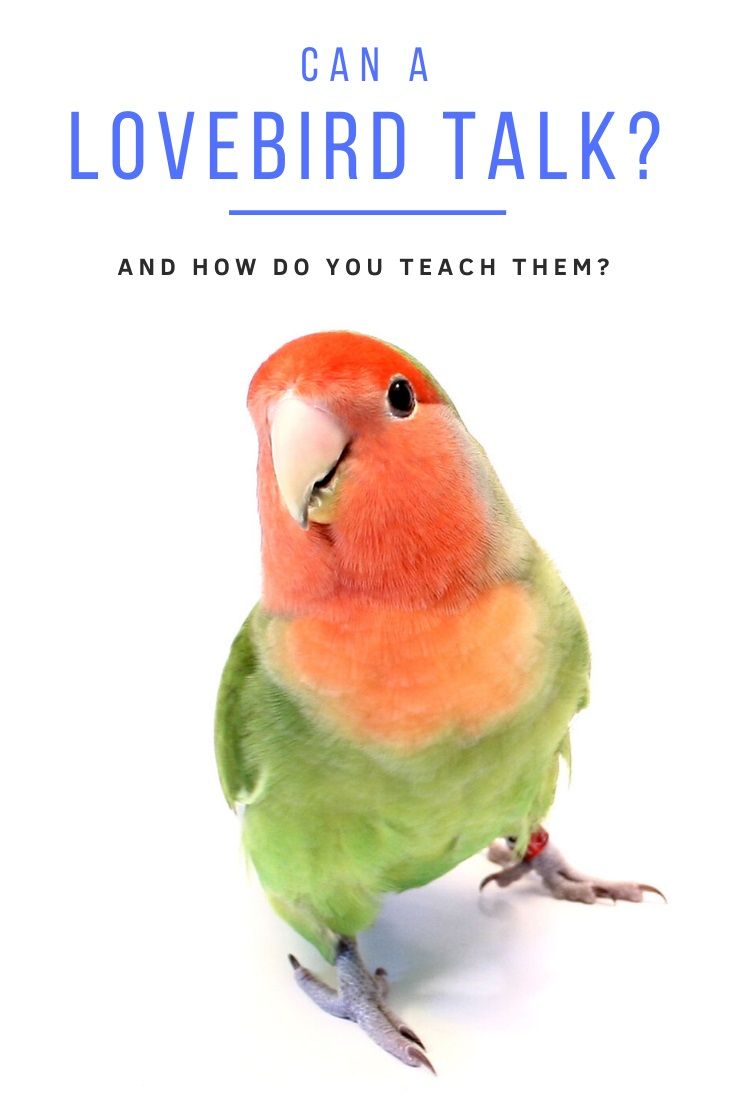
Teaching your lovebird to talk
If you’d like to get your lovebird to repeat phrases or tunes, keep in mind that as with any bird, not all of them will be receptive to it. Some lovebirds will turn out to be relatively easy to teach while others just stubbornly refuse to produce any speech ever.
Factors that can influence your lovebird’s ability to learn to speak are, among others:
- Age. A young lovebird will be much more willing to learn anything new and that includes learning to speak. Although older birds can learn, it’ll generally be a lot easier if you start early.
- Upbringing and tameness. A hand-raised lovebird will see you as a member of its flock more than an untamed one. It’ll usually be more receptive to training and might imitate your speech more readily.
Again, no reason to give up by default if your lovebird isn’t tame, as it is still possible. It might just take some more effort and time.
- You. As I always say, a very large portion of your parrot’s ability to learn anything doesn’t actually depend on the bird, but on you. Training any parrot, including lovebirds, takes a lot of effort, patience and repetition.
If you’re not willing to invest the time, then your chances of success are going to be pretty slim.
Interesting! For many birds that talk, gender plays a big role in their ability to pick up the skill, with males being much more likely to. With lovebirds, however, many owners report the females being (almost) just as good at it as the males. There might still be a gender difference but it appears smaller than with other species.
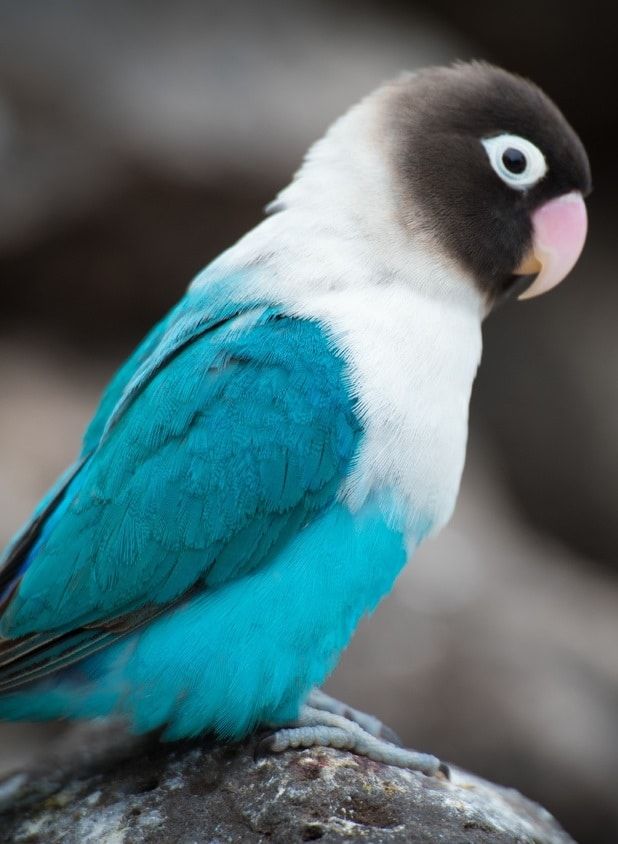
Talking training
In order to try and teach your lovebird to talk, you can take the steps below. Again, keep in mind that it won’t always work, but with dedication and time, you might be able to coax some speech out of your lovie.
- Pick your words. Keep it simple! Try the bird’s own name to start with, or a very short phrase like ‘pretty bird’ or ‘love you’. If the bird picks that up you can start considering attempting something more challenging. You can also try a short whistle consisting of just a few tunes.
- Make your lovebird comfortable. It should associate you with happy times, even if it’s not hand-tame. Make sure it’s healthy with a properly varied diet and plenty of stimulation in the form of fun toys. Whenever you approach the cage, offer a little snack or some out-of-cage time.
- Positive association. While you do the previously mentioned, chat to your lovebird. It’ll hopefully start associating your voice and the words you say with positive things, making it more likely to want to repeat you.
You can say anything to get your bird used to your voice, but obviously, it’s important to make sure the word, phrase or tune you chose is repeated frequently. Which brings us to…
- …Repetition. In order to get a (love)bird to talk, the phrase should be absolutely lodged in its mind. You’ll probably be repeating it for weeks or months on end before hearing the bird even attempt to mimic it!
You can even record yourself or use one of the many parrot talking training videos on YouTube, although real-life interactions are of course going to be the most effective.
- Reward. If you’re hanging out with your lovebird and hear it (try to) say a word or phrase, reward it immediately while repeating the word(s) in question. It’s handy to always have some of your bird’s favorite treats nearby for this purpose.
If your lovebird is tame enough that it will sit with you when you take it out of its cage, you can do one or multiple dedicated training sessions a day. Take the bird out and offer some nice head scratches and maybe a treat or two while continually speaking to it in a clear voice.
Some lovebirds respond well to being gently bobbed up and down or side to side in order to get them to speak. Seeing themselves in a reflective surface might also encourage them to start a serenade, as will some (often random) objects.
Tip: Is your lovebird really not receptive at all to the word, phrase or tune you chose? Try switching it up. It might simply not like it or find it too difficult.
Do keep in mind that teaching it many different things can result in the bird forgetting some of them or start mashing them together (which is funny enough in its own right).
Examples of lovebirds talking
The videos below are good examples of what talking lovebirds will sound like. Their voices are not super clear (and very high-pitched!) but you’ll definitely be able to make out some words and phrases.
Note how all of them are short and sweet, making them easier for the bird to pick up than something longer.
If you have any more questions about lovebirds talking or if you want to share your own experiences with these small, feisty African parrots, don’t hesitate to leave a comment below.
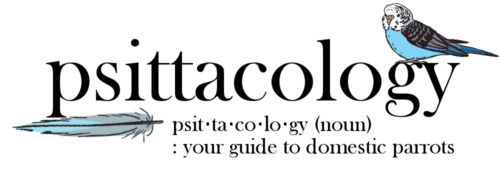
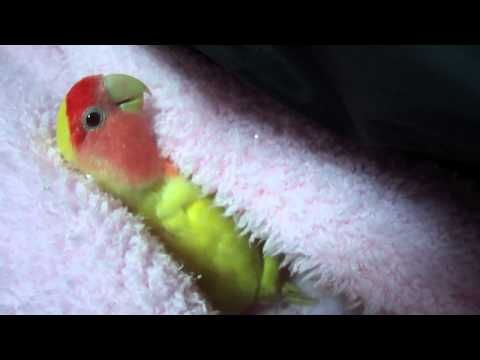
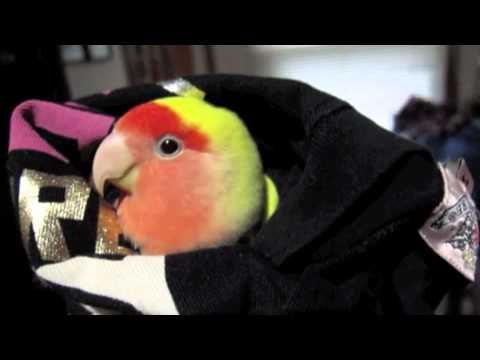
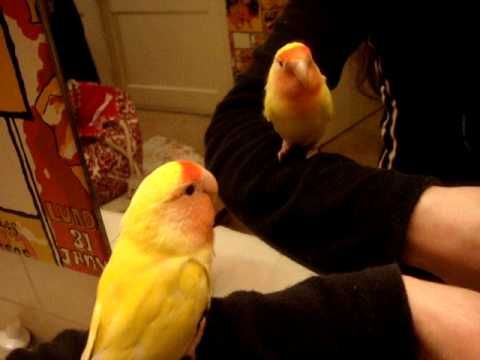
Great piece!